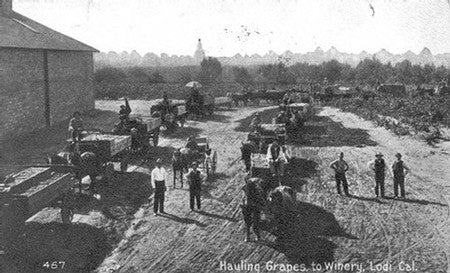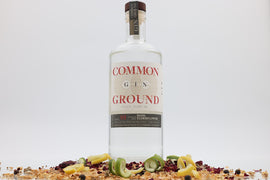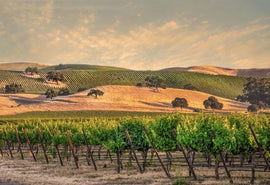Beyond Napa and Sonoma
It is often overlooked that California wine extends far beyond the AVAs of Napa and Sonoma. This month, we aim to highlight the diverse offerings of other wine regions in California. American Viticultural Areas (AVA) are officially designated regions for growing wine grapes in the United States. The boundaries of an AVA are determined by the Alcohol and Tobacco Tax and Trade Bureau (TTB), based on geographic characteristics. California currently boasts 149 AVAs, with Napa Valley AVA being the very first, established in January 1981. (Fun fact: The first AVA in the United States was actually in Augusta, Missouri, and there are currently a total of 269 AVAs in the United States). Presently, Napa Valley encompasses 16 sub-appellations, while Santa Barbara County is home to seven distinct AVAs. Santa Maria Valley, established in the autumn of 1981, was the second AVA to be recognized in California.
Santa Barbara County has a history of wine making and wine grape growing stretching back more than 200 years to before California was a State. From the Mission Era of early California through the Ranchero and Pueblo Era, struggling through Prohibition to the beginning of the modern era of wine making that started in the 60’s, Santa Barbara County continues to combine traditional, hand-made techniques, with the latest innovations in grape growing and wine making.
Our Santa Barbara wine comes from Curran Wines. Utilizing 50 years of combined winemaking experience, Bruno D’Alfonso and Kris Curran, a husband-and-wife team, offer a collection of exceptional wines and unique varietals under four different labels. The Curran label, which was the first label Kris established in 1997, concentrates mainly on vineyard-designated Spanish varietals including Grenache, Grenache Gris, Grenache Blanc, and Tempranillo. Kris & Bruno have developed long-standing relationships with some of the best vineyards located in Santa Barbara County. Currently, they source from several highly reputable vineyards, as well as a few that they would like to keep secret.
The second wine we selected is produced from grapes cultivated in Lodi, which obtained its AVA status on 2/13/1986. Lodi, much like the rest of California, has a historical connection to the Gold Rush. As aspiring miners rushed to seek their fortunes, settlements emerged in nearby regions. Lodi was conveniently located within a day's journey from the bustling activity. Early inhabitants characterized Lodi as a fertile grazing land, adorned with clusters of wild grapes hanging from the trees. Despite the seemingly divine indication, wine grapes were not originally the primary crop in Lodi. In the beginning, growers took a chance on wheat, then watermelons, before ultimately settling on one of Lodi's most reliable crops - grapes.
With its vast size and high productivity, Lodi stands out as a prominent AVA in California. Lodi surpasses both Napa and Sonoma in terms of grape cultivation, accounting for approximately 20% of California's wine grape production. While commonly grouped with warmer wine regions, Lodi's climate resembles that of Paso Robles or Healdsburg. The region experiences warm summer temperatures, which are moderated by the pleasant Delta Breeze - a cool coastal air flow that delicately sweeps through the Carquinez Strait during peak daytime heat.
A curious soul with creative inclinations, Jay Nunez of No Love Lost found himself infatuated with the vinification process, sustainable agriculture and the Napa Valley wine community. This infatuation turned into obsession, filling his home with wine projects while working two jobs and going to school. Those wine projects as well as exposure to the heart of the American wine industry slowly showed him less is more, which led him into his current minimal interventionist perspective on winemaking. While production is in Napa Valley and grapes are sourced from a limited number of vineyards in the valley, many of their bottlings are also sourced from small family-owned vineyards from other regions within Northern California.
Cheers!
Carrie Upson - General Manager and Wine Buyer
|
No Love Lost Counoise |
|
|
Region / Country of Origin: Lodi, California |
About the vineyard: Harvested from the Claypool vineyard, an organic site on the west side or Lodi, a fascinating story unfolds. In 2016, the Zinfandel vines were pruned and replaced with Counoise scions, igniting a new movement. This small yet remarkable site is characterized by sandy loam soil and a Mediterranean climate that imbues it with unique qualities and character. About the winemaking: The fruit was carefully placed into a closed-top fermentation tank, sealed and then allowed to sit for a few weeks. After allowing fermentation to begin indigenously intracellularly via carbonic maceration, the fruit was foot tread and then pressed off. Fermentation was completed in all neutral French oak. Tasting Notes: 2022 was a year that saw a bit more natural extraction for this Counoise. Still not dark by any means but hue and savory notes were heightened in this growing season. Still carbonic and still poppy fresh, this is Jay’s favorite wine. The resulting wine is light, airy, and bouquet drive with notes of light plum, strawberry, pepper and licorice. The electric hue of this wine is as fun to look at as it is to drink. Served best at cellar temperature or slightly chilled. |
|
Enologist: Jay Nunez |
|
|
Special Club member price: $27.99 btl/$302.29 cs $40 retail on No Love Lost’s site! |
|
|
Suggested Food Pairing: Grilled or BBQ Poultry, Cheeses like Pecorino, cheddar and gouda, Grilled Salmon, Mushroom Risotto. |
|
|
Curran Grenache Blanc 2022 |
|
|
Region / Country of Origin: Santa Barbara County, CA |
About the Winemaker: Kris Curran continues to fulfill her innovative standing as the first Californian vintner to popularize Grenache Blanc which she started making in 2003. Her love for Spanish varieties prompted her to take up the challenge of mastering different production techniques: “I have come to appreciate the unique personality of each variety with which I work. I combine this understanding with my scientific knowledge in pursuit of crafting the best wine possible.” About the winemaking: Hand-sorted fruit was whole cluster pressed. The juice then settled for 2 days at 30°F before it was racked cleanly and inoculated for primary fermentation. It was maintained at 60-62°F in Stainless Steel Tanks until fermentation was complete; this wine was not allowed to undergo Malolactic fermentation. Tasting Notes: A clean and fruity, dry white wine with notes of ripe mango, white peaches, and hints of passion fruit and elderflowers. Medium bodied, with balanced acidity, firm tannins, and a clean, crisp finish. |
|
Enologist: Kris Curran |
|
|
Price: $23.99 btl/$259.09 |
|
|
Suggested Food Pairing: Perfect as a “patio” wine, to sip by itself, it also pairs extremely well with spicy foods including Mexican, Thai and Indian cuisines. |
|





